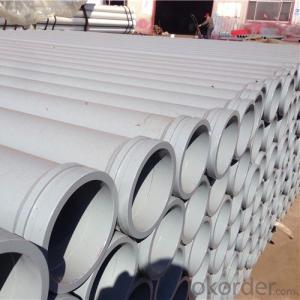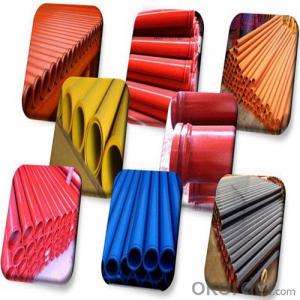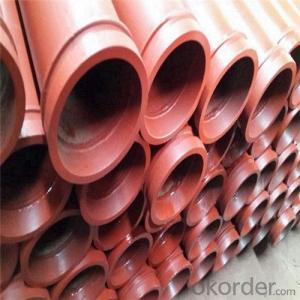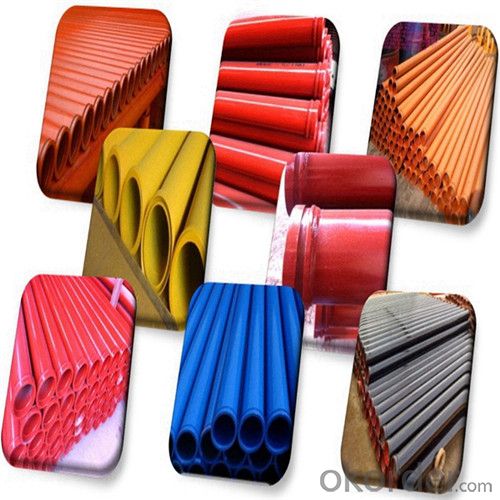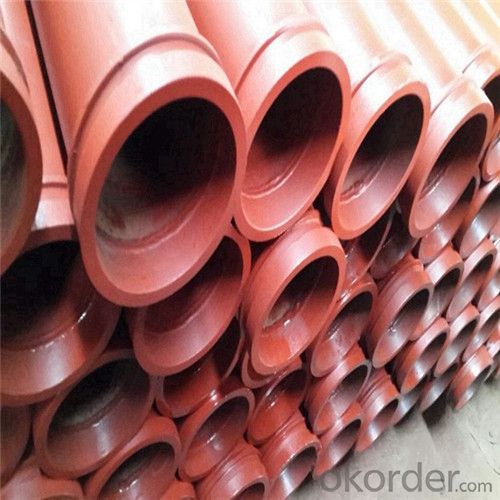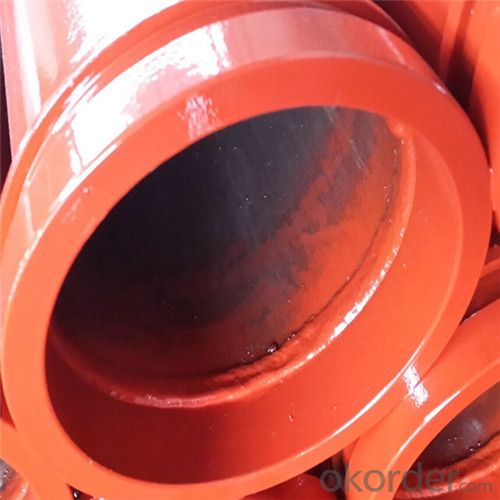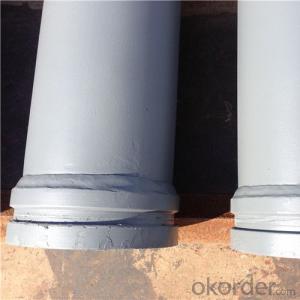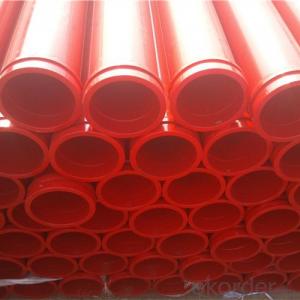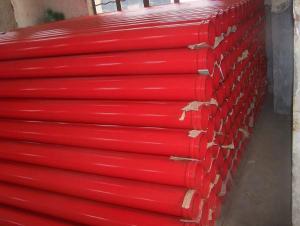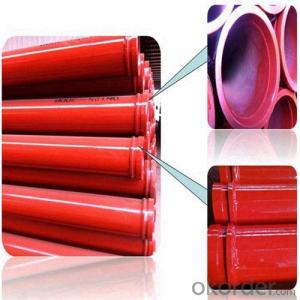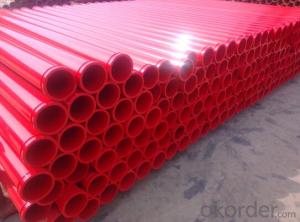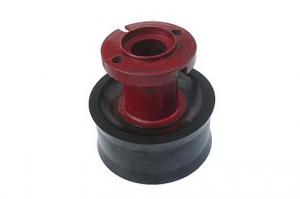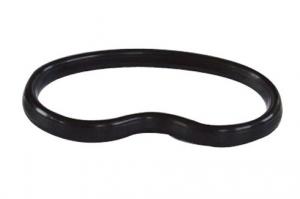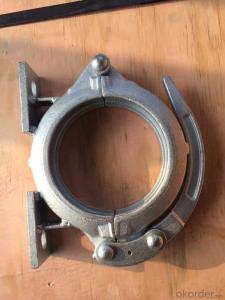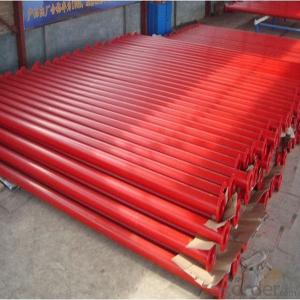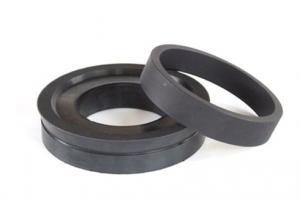3M 45# Steel Delivery Pipe for Concrete Pump
- Loading Port:
- Tianjin
- Payment Terms:
- TT or LC
- Min Order Qty:
- 50 pc
- Supply Capability:
- 5000 pc/month
OKorder Service Pledge
OKorder Financial Service
You Might Also Like
3M 45Mn2 Delivery Pipe for Concrete Pump
1. Structure of 3M 45# Steel Delivery Pipe for Concrete Pump:
St52 Weld Pipe: Main use for Trailer-mounted pump, thickness has 4.0mm, 4.5mm, 5mm. Compare with for Truck-mounted pump. Weld pipe has cheaper price, so it is popular in Saudi, Pakistan, India, etc. Unit Price is about 30USD-33USD.
St52 Seamless Pipe: Now More People like use this kind for Truck Pump and Trailer Pump because of the quality is better and it is seamless kind, so this kind pipe is most popular in Middle East Price About 34USD-37USD.
Wear Resistant Pipe: Use for Truck Pump, Wear Resistant Layer is 2.5mm.Through heat treatment way make this pipe more strong (HRC60-62), Using Life: 25,000m³-35,000m³ Price about 65USD-68USD.
2. Main Features of 3M 45# Steel Delivery Pipe for Concrete Pump:
• High Wear-resistant, long service life, lower cost
• In case of quality problem the company provide free replacement.
• Provide consumers with regular visits
• Ensure the supply of ancillary parts
• Our company passed the ISO9000 certification, the product through 3C certification.
3. 3M 45# Steel Delivery Pipe for Concrete Pump Images
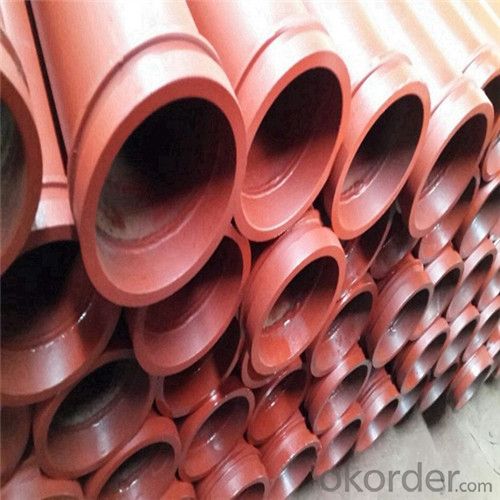
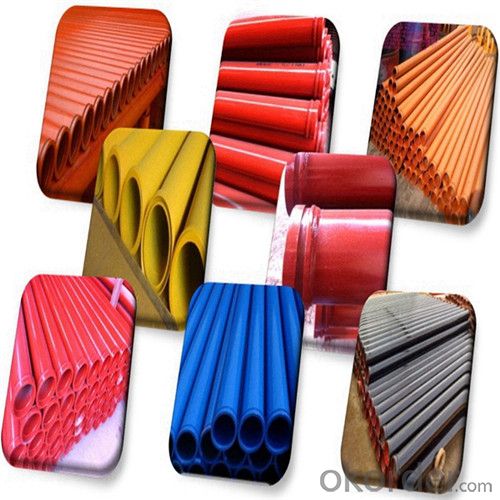
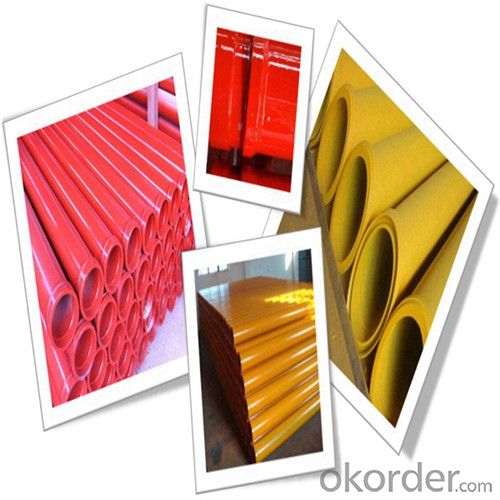
4. 3M 45# Steel Delivery Pipe for Concrete Pump Specification
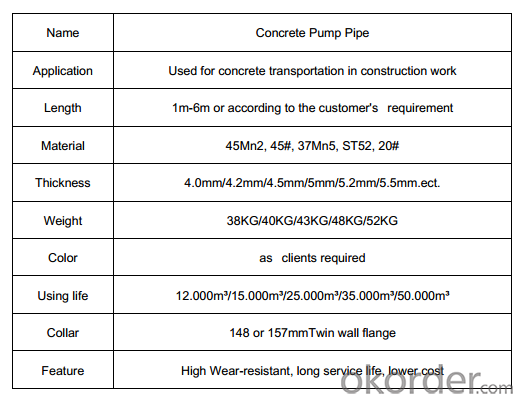
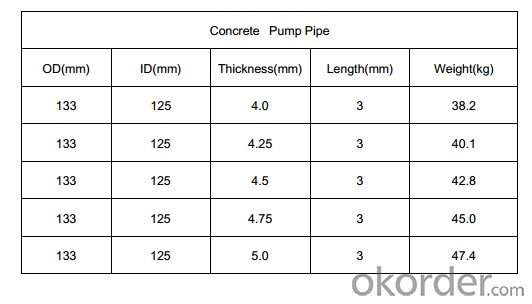
6. Why choose us
• We are a comprehensive manufacturing and trading company.
• Our company is one of the biggest manufacturing and trading companies in China.
• We have been specialized in producing concrete pump spare parts and specialized in producing all kinds of concrete pump parts. As Concrete Pump Pipe, Concrete Pump Elbow, Concrete Pump Rubber Hose, Concrete Pump Wear Plate, Concrete Pump S Valve, Concrete Pump Piston and so on.
• We are famous for our superior quality, competitive prices, first-class craftworks, safe package and prompt delivery.
• We have been supplying concrete pump parts for SCHWING, PUTZMEISTER, SANY, CIFA, KYOKUTO, ZOOMLION for 10 years, so we can promise you the quality and best price.
- Q: What are the signs of wear and tear in concrete pump spare parts?
- Some signs of wear and tear in concrete pump spare parts include: 1. Surface damage: Concrete pump spare parts, such as pipes and hoses, may show signs of surface damage like cracks, dents, or scratches. These can be indicators of wear and tear, especially if they are deep or extensive. 2. Corrosion: Concrete pump spare parts that are made of metal, like couplings or clamps, may show signs of corrosion over time. This can include rusting or pitting on the surface, which can weaken the part and affect its functionality. 3. Leaks: If there are noticeable leaks in the concrete pump spare parts, such as in the seals or gaskets, it can be a sign of wear and tear. Leaks can occur due to the degradation of the material or improper installation, and they can affect the efficiency and performance of the pump. 4. Reduced performance: Wear and tear in concrete pump spare parts can lead to a decrease in overall performance. For example, if the wear plates in the pump are worn out, it can result in reduced pumping capacity or increased energy consumption. 5. Increased noise or vibrations: If there is an increase in noise levels or vibrations during the operation of the concrete pump, it can be a sign of wear and tear in the spare parts. This can occur due to imbalances, misalignments, or loose components, which can affect the pump's performance and longevity. 6. Excessive wear on moving parts: Moving parts in the concrete pump, such as pistons or cylinders, can show signs of excessive wear and tear. This can include scoring or grooving on the surface, which can impact the smooth operation of the pump and lead to further damage if not addressed. Regular inspection and maintenance of concrete pump spare parts is crucial to identify and address any signs of wear and tear early on. Prompt replacement or repair of worn-out parts can help to prevent further damage and ensure the efficient and safe operation of the concrete pump.
- Q: What is the role of a concrete pump agitator shaft seal?
- The purpose of a seal on the agitator shaft of a concrete pump is to prevent any substances, like concrete or grout, from leaking or seeping out. Its design aims to create a secure seal between the rotating shaft and the fixed housing, guaranteeing that no materials escape while the pump is in use. This is crucial for upholding the pump's efficiency and effectiveness by preventing any loss of material. Additionally, the seal safeguards the agitator shaft from potential harm caused by external contaminants such as dirt or water, which could potentially damage the pump. Overall, the concrete pump agitator shaft seal is essential for ensuring the pump operates smoothly and reliably while maintaining the quality of the materials being pumped.
- Q: How to diagnose the blockage in the inlet of concrete pump?
- Make the pump reverse running to destroy the caking, return the concrete to the hopper, stir it again, and then pump it forward
- Q: What are the different types of concrete pump hydraulic filters?
- Construction projects commonly utilize various types of concrete pump hydraulic filters. These filters are crucial for ensuring the hydraulic system's smooth operation and longevity. 1. Suction filters, located at the hydraulic pump's intake side, play a vital role in removing larger particles and debris from the hydraulic oil. They prevent contaminants from entering the pump and causing harm to its components. 2. Positioned on the return line, return line filters are designed to eliminate smaller particles and contaminants from the hydraulic oil before it is returned to the reservoir. By maintaining oil cleanliness, they prevent system wear and tear. 3. Pressure line filters, typically installed after the hydraulic pump on the high-pressure side, remove fine particles and contaminants from the oil. Their purpose is to guarantee the valves, cylinders, and other hydraulic components work smoothly. 4. In-tank filters are submerged in the hydraulic oil reservoir to filter the oil as it circulates through the tank. They effectively eliminate larger particles and contaminants settled at the bottom of the reservoir. 5. Magnetic filters attract and remove metallic particles, such as iron filings and metal shavings, from the hydraulic oil. They are highly effective in capturing ferrous contaminants. 6. Breather filters, installed on the breather vent of the hydraulic oil reservoir, maintain the cleanliness and integrity of the hydraulic oil by preventing dust, dirt, and moisture from entering the system. Regular inspection and replacement of these hydraulic filters are crucial for optimal performance and longevity of the concrete pump's hydraulic system. Neglecting this maintenance can lead to increased wear and tear, decreased efficiency, and potential damage to the pump and its components.
- Q: What is the function of a concrete pump control valve?
- The purpose of a concrete pump control valve is to regulate the concrete flow from the pump to the desired location. By controlling the speed and direction of the concrete, it ensures precise placement. Furthermore, the control valve aids in preventing blockages in the pumping system by enabling the operator to adjust the pressure and flow rate of the concrete. Moreover, it contributes to the safety of the operation as the operator can stop or start the concrete flow as required. In conclusion, the concrete pump control valve is essential for the efficient and effective transfer of concrete from the pump to the desired location.
- Q: What is the purpose of a concrete pump control panel?
- Operators use a concrete pump control panel to centrally control different functions and parameters of the concrete pump. By using this panel, operators can initiate and halt the pump, manage its speed and direction, and monitor and regulate the flow and pressure of the concrete being pumped. Safety measures like emergency stop buttons and alarms are also incorporated in the control panel to safeguard both the operators and the equipment. Additionally, the control panel may have diagnostic capabilities that present real-time data and alerts for maintenance and troubleshooting purposes. In summary, the aim of a concrete pump control panel is to improve efficiency, precision, and safety in the concrete pumping process.
- Q: Can I get spare parts for concrete pump hydraulic systems?
- It is indeed feasible to acquire spare parts for hydraulic systems of concrete pumps. Numerous manufacturers and suppliers present an extensive selection of spare parts exclusively crafted for concrete pump hydraulic systems. These spare parts encompass hydraulic cylinders, valves, hoses, filters, seals, and other indispensable components. To guarantee compatibility while procuring spare parts, it is crucial to ascertain the precise make and model of the concrete pump hydraulic system. Moreover, it is advisable to obtain spare parts from trustworthy suppliers or manufacturers to assure excellent quality and dependability.
- Q: How often should agitator shaft seals be replaced in a concrete pump?
- The frequency at which agitator shaft seals should be replaced in a concrete pump depends on several factors such as the type and quality of the seal, the operational conditions of the pump, and the maintenance practices followed by the user. However, as a general guideline, it is recommended to inspect and replace agitator shaft seals in a concrete pump every 500 to 1,000 operating hours or annually, whichever comes first. Regular inspection of the seals is crucial to identify any signs of wear, leakage, or damage. If any of these issues are detected, immediate replacement is necessary to prevent further damage to the pump and ensure optimal performance. Additionally, it is essential to follow the manufacturer's recommendations and guidelines regarding seal replacements, as they may provide specific instructions based on the pump model and seal type. Proper maintenance practices, including regular cleaning and lubrication of the seals, can also extend their lifespan and reduce the need for frequent replacements. It is important to keep in mind that failure to replace worn or damaged agitator shaft seals in a timely manner can lead to increased downtime, decreased efficiency, and potential damage to other components of the concrete pump. Hence, it is crucial to prioritize regular inspection and replacement of agitator shaft seals to ensure the smooth operation and longevity of the concrete pump.
- Q: How can one determine the correct weight and balance requirements for concrete pump spare parts?
- To ascertain the appropriate weight and balance specifications for concrete pump spare parts, several factors must be taken into account. First and foremost, consulting the manufacturer's specifications and guidelines specific to the concrete pump model is of utmost importance. These documents typically contain comprehensive information regarding the weight and balance requirements for each spare part. Secondly, it is essential to comprehend the function and purpose of each spare part. Different components vary in weight and can significantly impact the overall balance of the pump. For example, larger elements like booms or outriggers may necessitate precise weight distribution to ensure operational stability. Moreover, considering the intended usage and environmental conditions of the concrete pump is imperative. If the pump is expected to operate in challenging terrains or extreme weather, additional weight might be necessary to enhance stability. In addition to the manufacturer's guidelines, seeking counsel from experts or engineers knowledgeable about concrete pumps can provide invaluable insights. These professionals can analyze the specific requirements of the pump and offer guidance on the appropriate weight and balance specifications for the spare parts. Lastly, conducting thorough testing and inspections after installing any spare parts is crucial. This ensures compliance with the weight and balance requirements and allows for any necessary adjustments to be made. In conclusion, determining the correct weight and balance requirements for concrete pump spare parts necessitates a combination of understanding manufacturer guidelines, considering the purpose and conditions of the pump, seeking expert advice, and performing comprehensive testing and inspections.
- Q: How do I properly maintain and replace concrete delivery pipes in concrete pump spare parts?
- To ensure the concrete pump operates efficiently and safely, it is crucial to properly maintain and replace the concrete delivery pipes in spare parts. Here are some guidelines you can adhere to: 1. Conduct Regular Inspections: Frequently check the concrete delivery pipes for signs of wear, cracks, or damage. Look out for leaks or blockages that may hinder the concrete flow. Identify weak areas that may necessitate replacement. 2. Perform Thorough Cleaning: After each use, clean the concrete delivery pipes meticulously. Use water and a high-pressure hose to eliminate any concrete residue or buildup. This will prevent clogs and maintain a smooth concrete flow. 3. Apply Lubrication: Reduce friction and prevent concrete from adhering to the inner surface of the pipes by applying a suitable lubricant. This practice will elongate the life of the pipes and guarantee a seamless concrete flow. 4. Replace Worn-out Components: Regularly monitor the condition of the delivery pipes and promptly replace any worn-out or damaged parts. Over time, the pipes may corrode or develop cracks, thereby affecting their performance. Replace these components with premium spare parts to achieve optimal outcomes. 5. Handle with Care: Exercise caution when handling the concrete delivery pipes to avoid unnecessary damage. Refrain from dropping or mishandling the pipes during transportation or storage. Shield them from extreme weather conditions and store them in a secure, dry location. 6. Prioritize Training and Safety: Ensure that the personnel operating the concrete pump are well-versed in handling and maintaining the equipment. Educate them on the significance of regular inspections, cleaning, and part replacement. Emphasize safety protocols to prevent accidents and ensure the durability of the concrete delivery pipes. By adhering to these steps, you can effectively maintain and replace the concrete delivery pipes in spare parts for the concrete pump. Consistent maintenance and prompt part replacement will extend the lifespan of the pipes and guarantee a seamless concrete flow during construction projects.
Send your message to us
3M 45# Steel Delivery Pipe for Concrete Pump
- Loading Port:
- Tianjin
- Payment Terms:
- TT or LC
- Min Order Qty:
- 50 pc
- Supply Capability:
- 5000 pc/month
OKorder Service Pledge
OKorder Financial Service
Similar products
Hot products
Hot Searches
Related keywords
